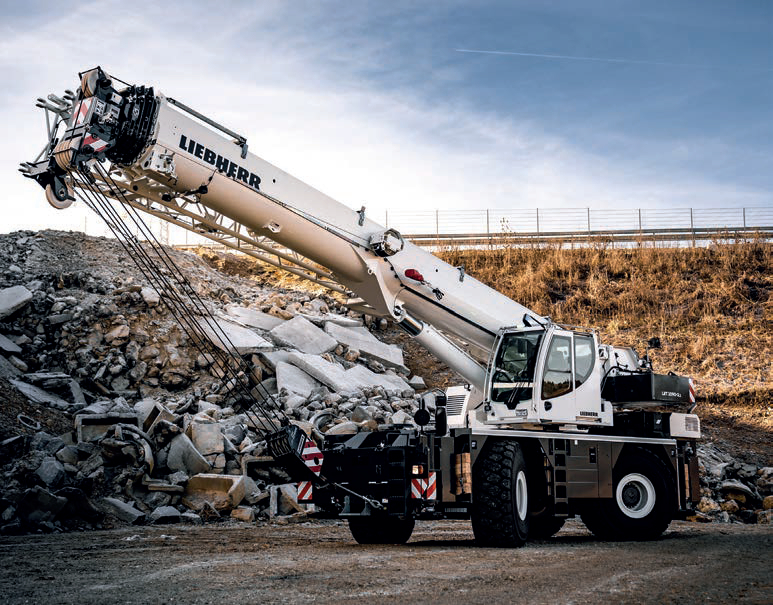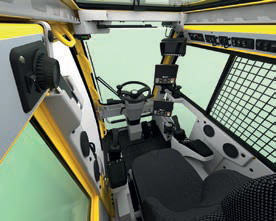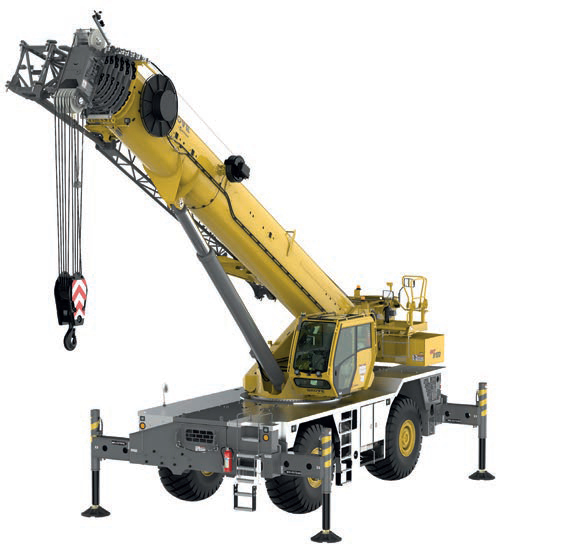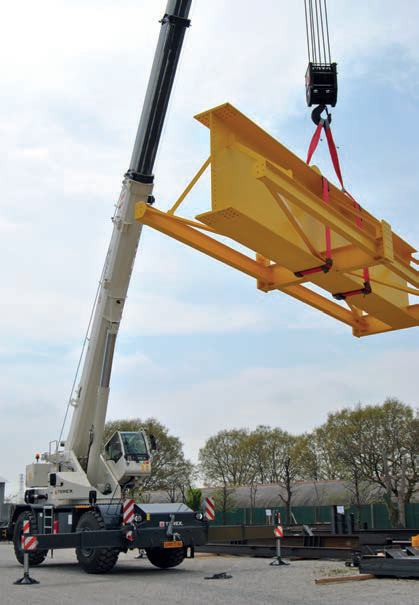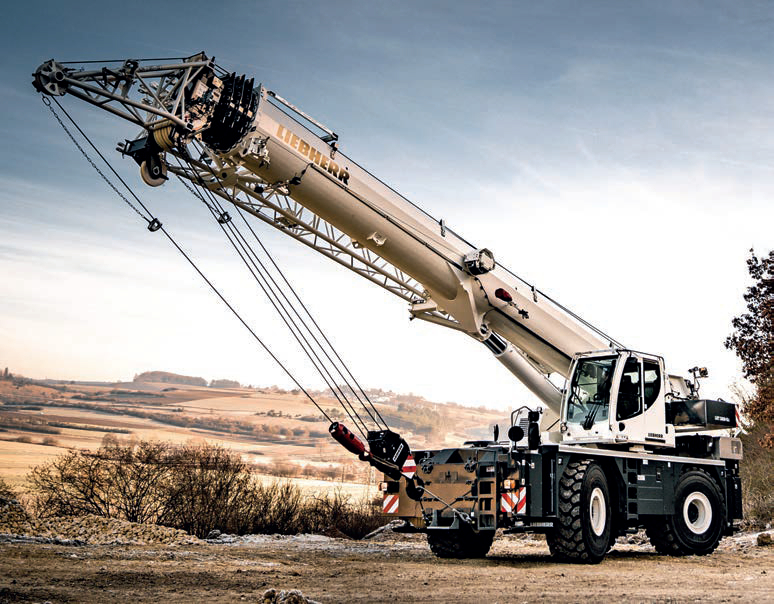Rough terrains in transition
22 July 2022Rough terrains will in future be powered by electricity or hydrogen. For the present, they are moving towards greener and more efficient operation. Julian Champkin reports.
We reported last month that Tadano were working on an all-electric rough terrain crane. In April 2021, the Tadano Group announced their 'Long- Term Environmental Targets', which include 25% reduction in CO2 emissions from business activities and 35% reduction in CO2 emissions from product use by 2030, and, even more importantly, achieving net zero carbon emissions by 2050.
Introducing the world’s first electric powered rough terrain crane is one of their key efforts for lowering product emissions. The crane is scheduled for introduction towards the end of 2030.
Until it comes along, Tadano point to their E-pack, which allows crane operation without starting the main vehicle engine; and they also point out that all their conventional diesel fleet can be operated without modification using HVO, Hydro-treated vegetable oil, as fuel – for more on which read on.
Liebherr, in 2020, bought out what they call their ‘LR 2100.1 unplugged’, an all-electric lattice crawler crane, surprising the market that such a large machine could be efficiently operated by battery power alone. They have not yet announced an equivalent electric-powered rough terrain crane; but they are working hard on zero-emissions drivetrains – and, as they point out, also on zero-emission lifecycle machines, which are an altogether higher and harder bar. It includes the emissions from mining and refining and casting the metal that makes up the machines, transporting it to the factory, and producing the machine and getting it to its end user. Only then do the emissions from operating it come into the sum; and at the end of its useful lifetime, the emissions and energy in recycling it add in to the final total. Saving the planet requires the whole sum of all those operations to be CO2 neutral.
On behalf of the Liebherr Group, the consulting firm Frontier Economics conducted a life cycle analysis of greenhouse gas emissions of typical construction machines equipped with various drive technologies. The experts determined exactly that sum – how much CO2 arises from production to operation through to the recycling of the machines.
“Emissions analyses are generally limited to the operating phase. This is not enough for our products because greenhouse gas emissions also occur in the upstream and downstream phases of construction machines’ lifecycles,” says Stephen Albrecht, Member of the Board of Directors of Liebherr-International AG. “To get a complete picture, we examined all stages of the life cycle, including the production of energy and provision of the infrastructure.” These results are combined in a so-called product carbon footprint, which describes the emissions of a product throughout the entire life cycle.
The study examined three types of construction machines: mobile cranes, truck mixers and wheel loaders. Perhaps unsurprisingly the study data showed that the different performance requirements of the three types require different drive technologies in order to reduce as much emissions as possible. For truck mixers, electric drives make the biggest contribution to emissions reductions. For mobile cranes, including rough terrains, operation with hydrotreated vegetable oil (HVO) shows the biggest immediate savings potential. It is important that the HVO is certified to be produced from plant and food waste, for example, and does not contain palm oil. ‘Green’ hydrogen made from CO2 neutral sources follows in second place.
Green hydrogen and properly-sourced HVO are both in theory CO2 neutral – in outline at least. In the long term, says the Liebherr study, operation with hydrogen seems optimal as the availability of HVO in the vast quantities required cannot yet be predicted. However, until the required hydrogen infrastructure and drive technologies are mature, HVO delivers the best results as an interim technology, particularly in existing fleets with combustion engines
“A wheel loader on an urban construction site, for example, is exposed to different conditions than a mobile crane used in the construction of wind turbines,” explained Albrecht. “The former can often be powered by electricity. In contrast, infrastructure projects in rural areas often lack the necessary power supply for an electrical connection, and more energy is often required there than can be provided with a battery-operated electric drive.
“In this light, battery electric should not be viewed as a universal solution, but as one important technology in the future drive mix. Apart from electric drives, it is just as important to closely monitor the topic of hydrogen. The regulatory conditions for producing hydrogen and e-fuels, which are made from renewable sources, must also be established. After all, the interaction of all these technologies allows optimal solutions to be created for all applications in the construction machinery sector.”
That is for the future. The current rough terrains of Liebherr are supplied from the factory with a full tank, not of diesel but of HVO. And they have been improved. “We recently upgraded our LRT 1090-2.1 and LRT 1100-2.1 rough terrains,” says Liebherr’s Wolfgang Beringer. “We increased the counterweight by one tonne to a total of 13 tonnes on the LRT 1090-2.1 and 15 tonnes on the LRT 1100-2.1; the result is lifting capacity that is 7 to 10 percent higher.
New also are side inclination load charts; and we have improved the rear view through improved design of the ballast.”
Meanwhile, from Terex, their three most recent rough terrains are the TRT 80, the TRT 90, and the TRT35. “They have been introduced to several different markets, and all three models are becoming very popular,” says Angelo Cosmo of their marketing department. “The TRT 35 is really appreciated for its compact dimensions and usability, and the TRT 80 and TRT 90 for their overall performance. The whole TRT range is equipped with the new TEOS control system, which has a ten-inch full-colour touchscreen displays, intuitive menu, full diagnostics and optional camera displays.
“We are planning to launch a new rough terrain in September,” says Cosmo. “Final testing is still going on so I can tell you more about that when the results are in. On future power sources we are evaluating the market demand for fully electric or battery powered RTs, and we are monitoring potential suppliers in order to identify the best possible solution for a mobile crane that is frequently used at isolated job sites. Important issues to consider are battery autonomy together with the ability to connect to whatever remote power source is available at the different sites. Hydrogen technology is also showing promising developments, both as an internal combustion fuel and in fuel cells.”
John Bair is rough-terrain product manager for Grove and their GRT range of rough terrains. “Today's GRT crane features were largely driven by market demand,” he says.
“We have redesigned and reengineered our rough-terrain cranes from the ground up to be more capable and reliable. The current range offers greater reliability, longer booms with strong capacities, enhanced operator comfort and improved efficiency. We are confident enough in these products that we now offer a standard two-year warranty on new GRTs with up to five years of total coverage.”
The Grove GRT8120 is the latest in the line-up. It has the longest boom and strongest load charts in its class, says Bair, and a new compact carrier design with flat decking for better manoeuvrability, serviceability and job site access. “Taken together these make the crane ideal for, among others, the petrochemical, construction and utilities industries.”
The capacity of the machine was also consumer-led. “Many of our customers wanted to fill a void in the 120 t(US) class; they also wanted to increase their crane utilisation with easier transportability, greater reach and capacity, and better access for serviceability.”
Its larger cousin, the GRT9165, is a 165 USt (150 t) capacity crane with a 205 ft (62.5 m) six-section, pinned boom. “That’s the longest reach in our line-up and is 5ft (2.5m) longer than the closest competing model,” says Bair. “We designed it for easy transport: its overall height is just 12.4 ft (3.7 m).”
The GRT9165 features a hydraulically removable counterweight system and outrigger boxes.
“Both are fully self-rigging, which eliminates the need for an assist crane during set-up. The new three-axle carrier has hydro-gas suspension on the rear axles lets you adjust the height for transportation and provides a comfortable ride as well. And it has Grove’s new, wider, full-vision cab with Crane Control System (CCS) which gives intuitive and efficient operation.”
The future for rough-terrains, then, is electric or hydrogen-driven; but until they come along there are plenty of options to choose from.
